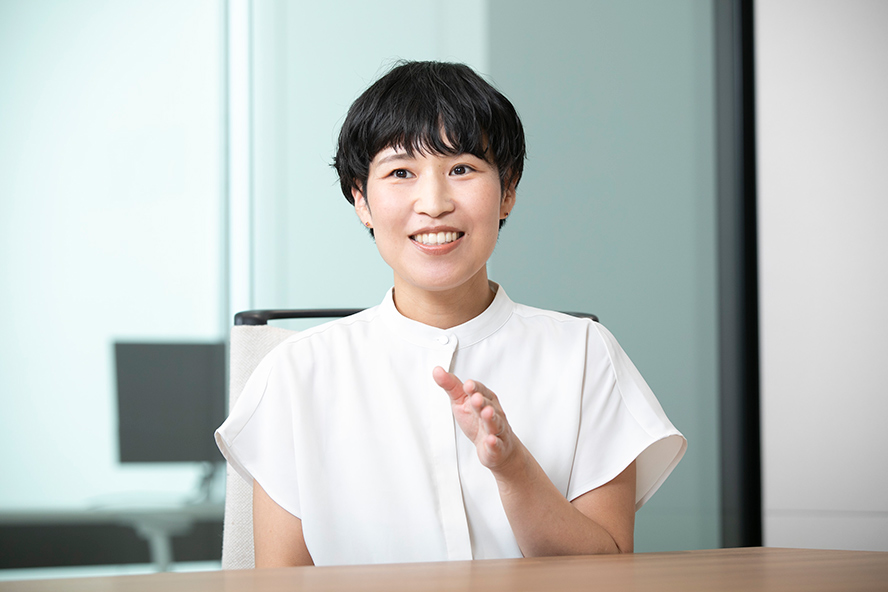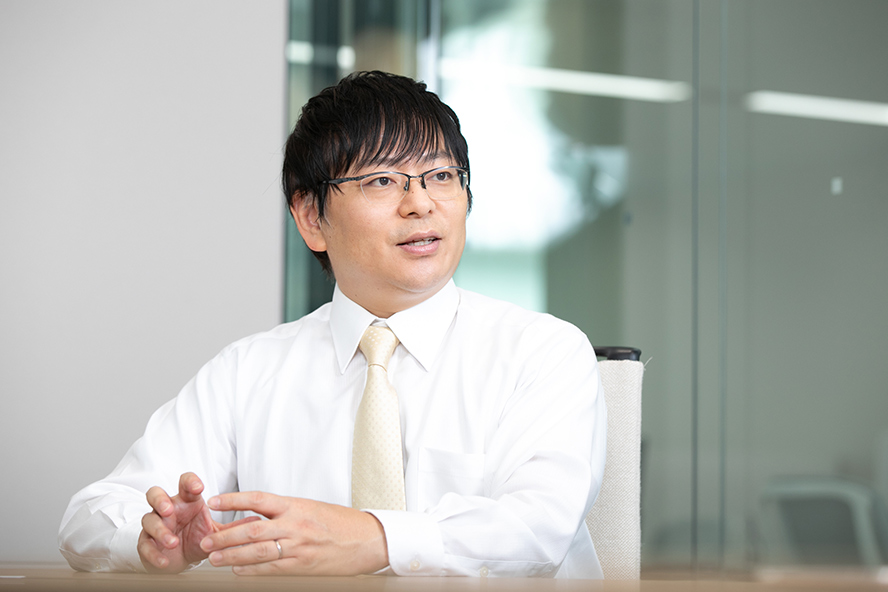- Home
- ABOUT US
- Shiseido Talks
- Shiseido's 30 Years of Basement Membrane Research Envisioning the Future of Skin from the Source of Skin Regeneration
Shiseido's 30 Years of Basement Membrane Research
Envisioning the Future of Skin from the Source of Skin Regeneration
August 29, 2024

Shunsuke Iriyama, Director of the Skin Beauty Value Development Department, MIRAI Technology Institute, Business Core Technology Center (left in photo)
Yuko Hachiya, Skin Shape Value Development Group, Skin Beauty Value Development Department, MIRAI Technology Institute, Business Core Technology Center (right in photo)
In 2024, Shiseido announced a new ingredient, "CoreXymide," opening a new era of basement membrane care. "Basement membrane," often referred to as the source of skin regeneration, has been the focus of Shiseido's research for over 30 years, dating back to the early 1990s. What kind of exploratory journey led to the discovery of "CoreXymide"? We spoke to two researchers who have been passing the baton of research from the past to the future.
―First, could you tell us about your current affiliations and roles?

Iriyama: I am a director at the Skin Beauty Value Development Department at the Business Core Technology Center. So, I’m basically in charge of the basic research department, a department that specializes in dermatology and life sciences. Since I was a student, I have always wanted to be a researcher, spreading value to the world through basic research. Because cosmetics is a field that integrates various research areas, when I joined Shiseido in 2004, the company’s stance was to nurture in-house, not only researchers who had completed their doctoral programs, but also those who had completed their master's programs. My wish was to make strides after joining the company, and I was interested in creating value by integrating fields.
Hachiya: I am researching skin "shapes" in the department led by Iriyama-san, focusing on wrinkles and changes in surface morphology due to aging. My mentor during university was Professor Toshio Nishiyama (former director of the Skin Biology Laboratories in Shiseido Research Center), who started collagen research at Shiseido. When I was a third-year student, he showed me an experiment with a "three-dimensional cultured skin model," something that was essential for basement membrane research. Finding it very interesting to see a structure like real skin being created in a culture dish using cells and collagen that had once been disassembled, I studied in Professor Nishiyama’s lab and then joined Shiseido. That's what led me to where I am now.

The History of Shiseido's Basement Membrane Research
―Today, we will be talking about the history of Shiseido's basement membrane care. The basement membrane, which has been a topic of discussion in the beauty world in recent years, has a history of over 30 years at Shiseido, starting with long-standing collagen research beginning in the early 1990s. In products around the year 2000, basement membrane care was discussed in the context of "early aging care."
- *1:The International Federation of Societies of Cosmetic Chemists (IFSCC): Founded in 1959 by the participation of cosmetic technologists' associations from eight countries. An organization started up by cosmetic technologists around the world dedicated to the development of more functional and safe cosmetic technologies.
- *2:"Prix d 'Excellence" sponsored by "Marie Claire" magazine. Established in 1985. Known as the most prestigious cosmetic award in the world. Judging is done through voting by influential beauty journalists from fashion and beauty magazines representing Europe, including France, evaluating all new products launched in France during the year—excluding fragrances—for their innovation, effectiveness, usability, packaging, and balance of quality and price.

―Why is that?
The Relationship Between Basement Membrane Research and Stem Cell Care
―Today, approaches targeting root causes, such as core training, and the rage about maintaining a healthy gut, easily reaches people’s hearts, but it was different then. So, you changed your appeal approach.
―It's interesting that researchers themselves consider ways to express their research results in a way that expands dreams.
The Long Journey of Repetitive Zooming In and Zooming Out with Colleagues
―I sense the difficulty and value of daily research that may not even end in a generation. Walking this long journey, sometimes thinking you have achieved results, only to have it not accepted much. Thus repeating the process from a different angle….

Iriyama: In the past, the discovery of a factor alone was news. These days at various academic conferences, people don’t just focus on one factor, but work on understanding what is happening in the skin as a whole and incorporating "omics research" that captures overall changes and phenomena. In other words, it’s now more about zooming out and having an overhead view. That's why we see more research from the perspective of conveying through concepts and philosophy. We also started to think that it is important to consider the timing of the times and that things need to be conveyed as a whole. Support from researchers in different fields within the company is also a great force. For example, creating a momentum to grow together even for research that has once been put on hold. I think this is an important source of energy when creating new value.
―Do researchers communicate with each other beyond their assigned areas within the company?
Announcement of New Ingredient "CoreXymide" in 2024
―In 2000, your senior, Amano-san, presented "Research on Skin Basement Membrane Care" in the oral presentation section of the IFSCC Berlin Conference and won the Best Award. According to company history, he pinpointed what is happening inside the skin at the initial stage of aging and developed Lipidure, an ingredient that can care for aging, early." And now, a new perspective has been added to basement membrane care with the new ingredient "CoreXymide."

We identified two enzymes after about two years of searching as a factor that causes damage to the basement membrane. The enzymes are MMP-9 and heparanase. We started screening from a huge sample library based on the hypothesis that if a component that inhibits the activity of the enzymes is found, basement membrane care will make a big leap forward. This was around the end of the 2000s.
―What do you mean by a huge sample?
―Is the process of checking 21,476 samples based on a hypothesis a dream come true for a researcher? Or...

Hachiya: I heard a legend about there being a tower of plates for the experiment. Apparently, the number of plates was so high that it reached the ceiling when stacked. Speaking of which, I remember seeing Iriyama-san present the efficacy data for these enzymes at an internal report meeting in my first year of joining the company. I was in a different group at the time, but I had learned the importance of basement membrane using skin models in university, so when I heard Iriyama-san saying that by inhibiting this enzyme you can repair so much of the basement membrane, I thought, "Wow, that's amazing!"
The Research Spirit Passed Down
―Being able to witness the work of a senior colleague when you set out on the vast ocean of research after joining the company sounds nice. I feel the passing down of the spirit of research.
―I guess it’s important to match the times and ride the wave. I got the image of passing the baton of research with conviction, aiming for the moment, and not just in one’s own generation, when results come out to the world.
―You can't catch up to your seniors? Even now?
Seeking a Better World Through Research
―"The backs I've seen are beautiful." Perhaps because there is beauty in the research itself that endlessly continue, it resonates with the heart that seeks the beauty of people. To end, what does a better world realized through research look like to you respectively?
―It's a bit of a mean question, but if Shiseido were to steer towards the goal of "Looking younger than now at all cost! That is, anti-aging being the absolute goal…will that make you rethink things?
ABOUT US
- Who we are
- History
- Profile
- Governance
- Quality Management
- Supply Network
- Region/Business
BRANDS
- Prestige
- Premium
- Inner Beauty
- Life Quality Makeup
SUSTAINABILITY
- Strategy / Management
- Society
- Environment
- Governance
- Reports / Data
- Related Information
INNOVATION
- Research and Development
- Research Areas
- Research outcomes
- Product safety
- Product Development Policy
- Initiatives for doctors and researchers
CAREERS
INVESTORS
- IR Library